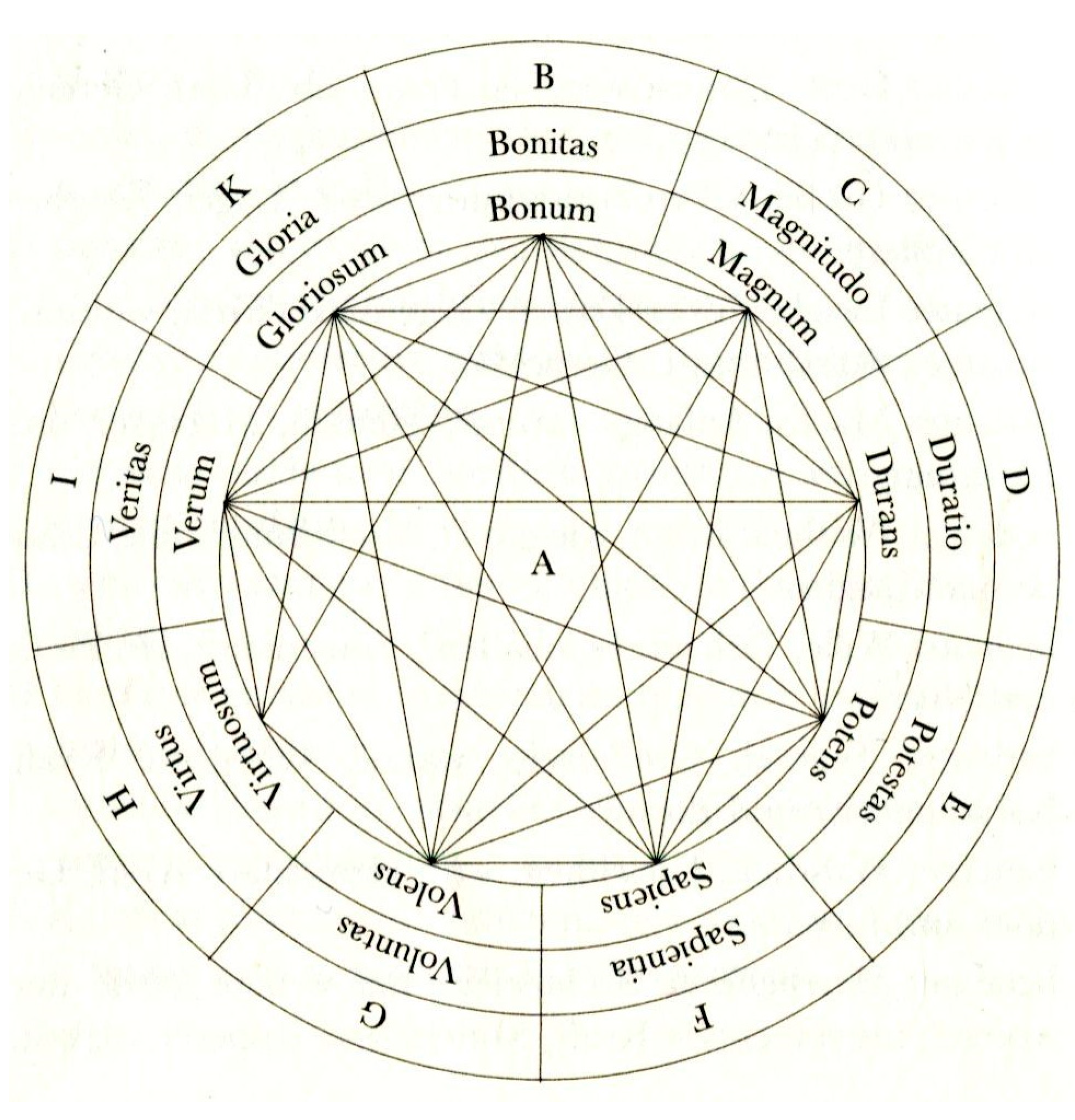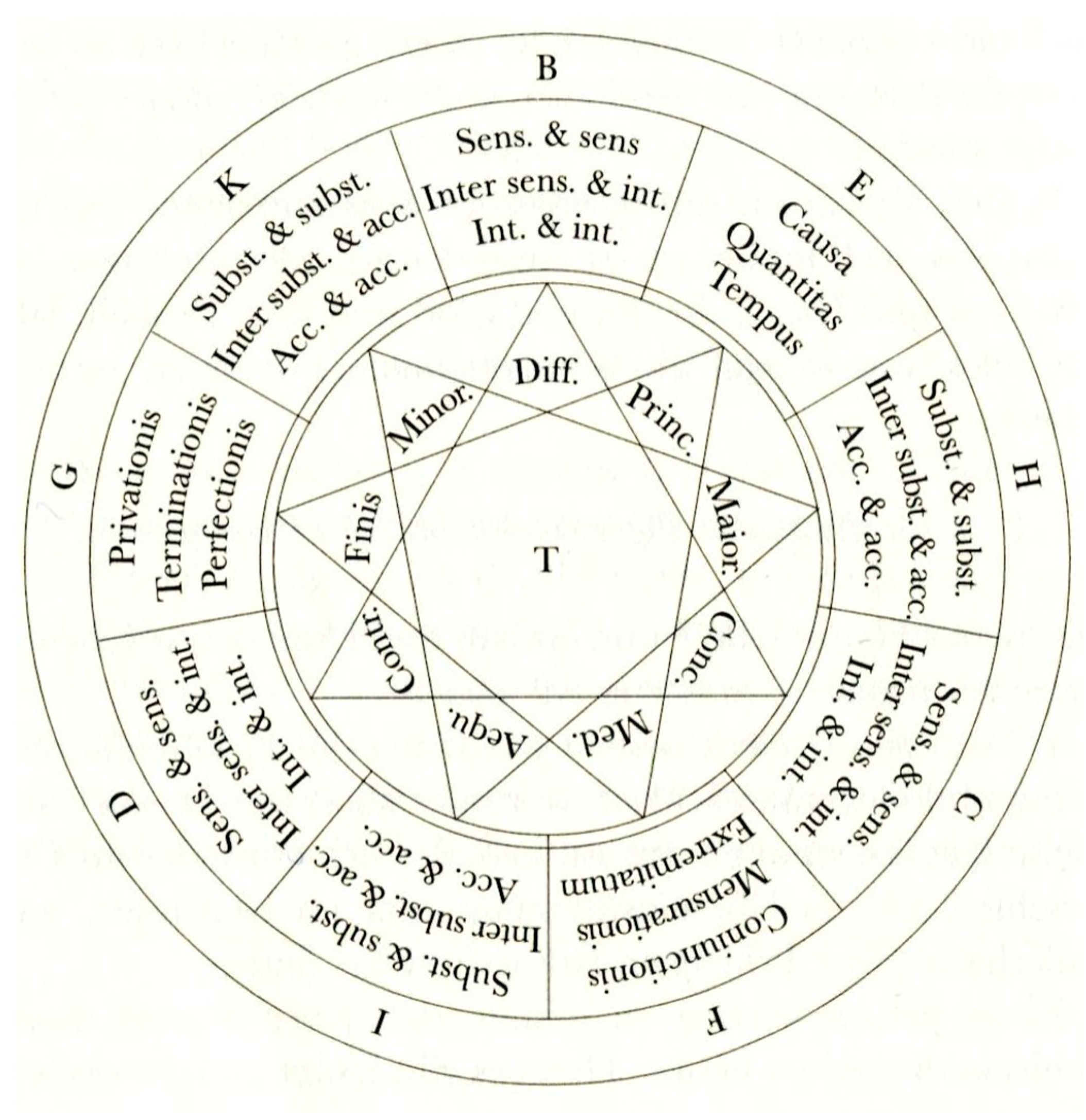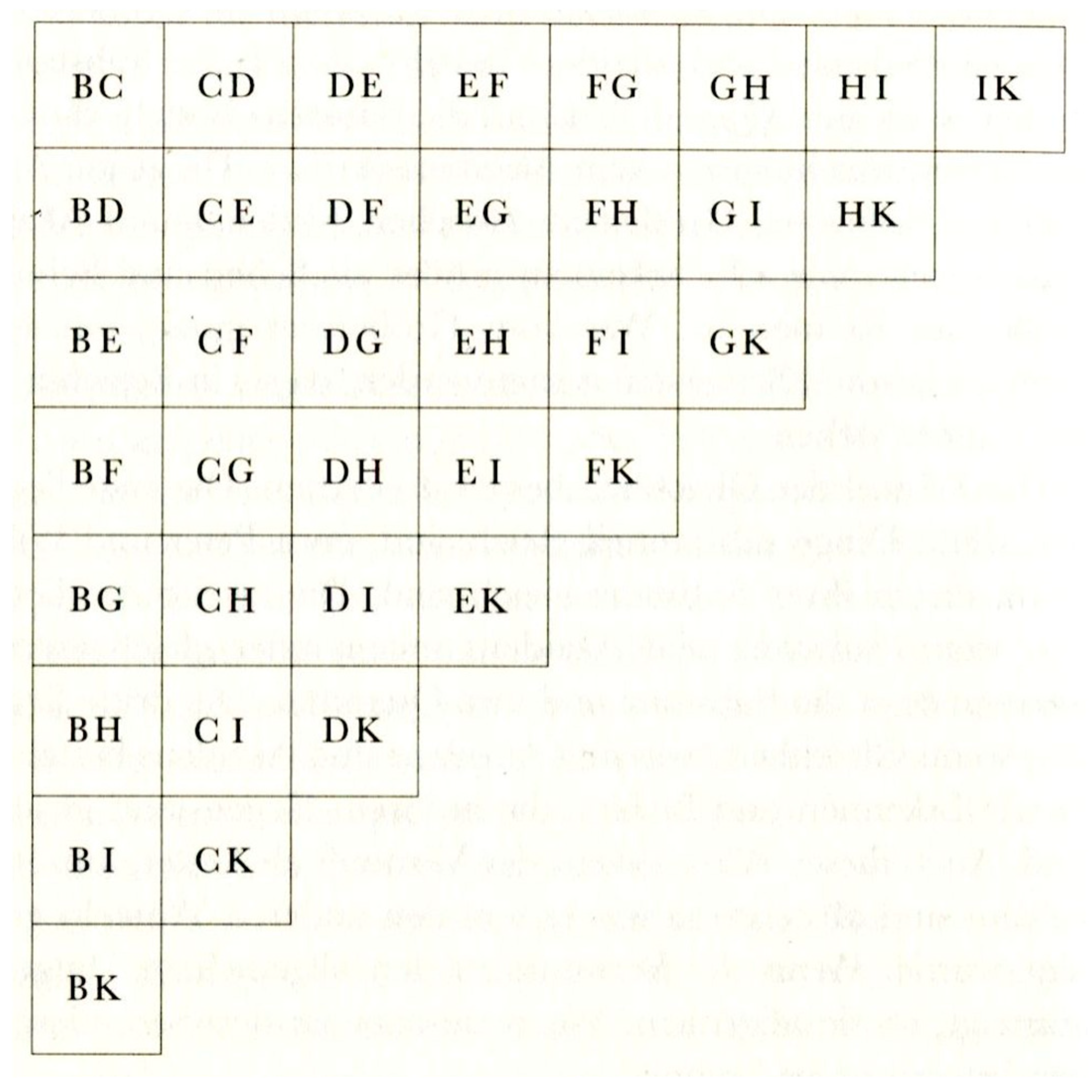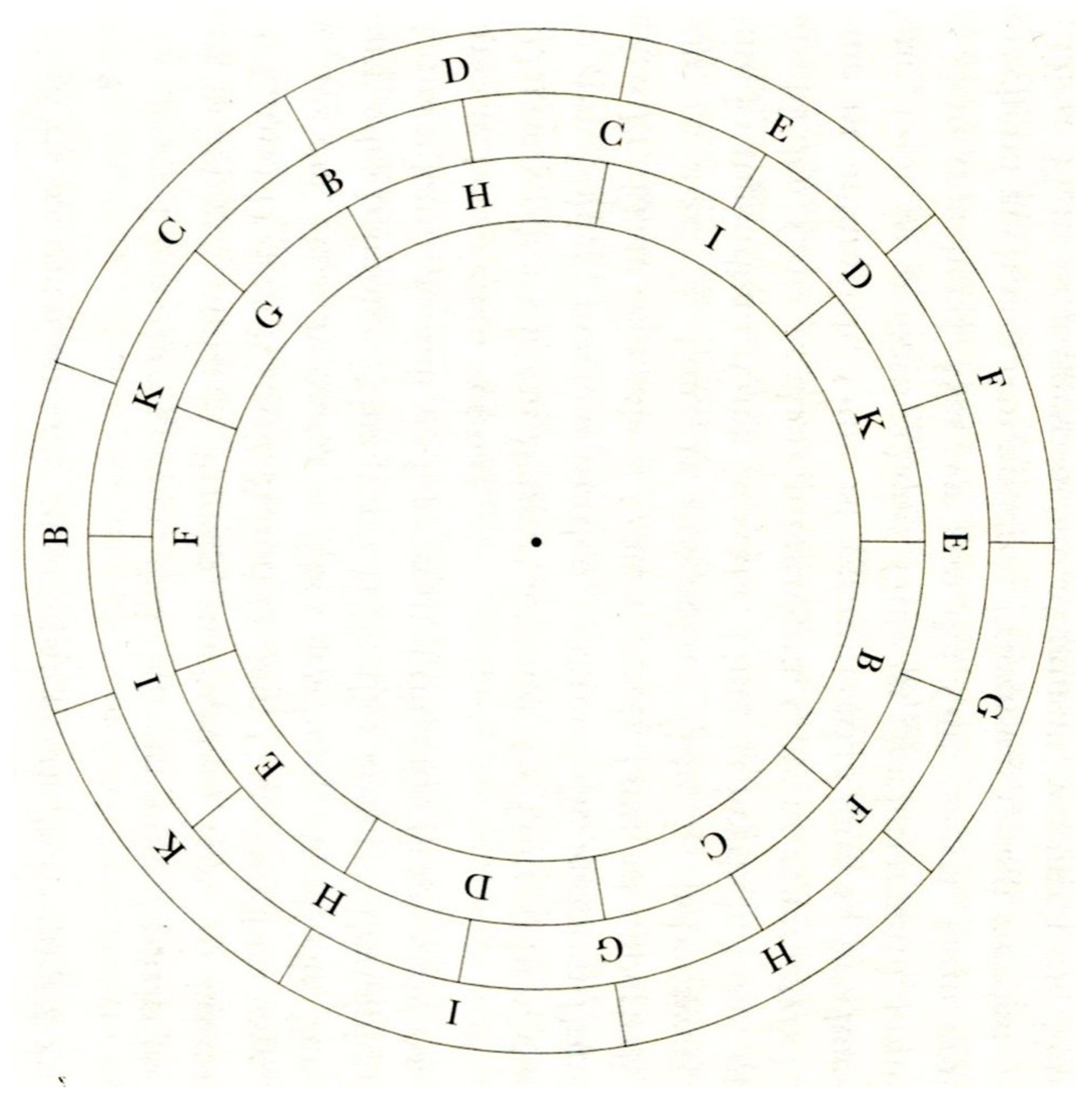Relations in Ramon Llull’s Trinitarian Ontology
Abstract
1. Introduction
2. Llull’s Understanding of Relations
3. The Doctrine of Correlatives
4. Necessary Reasons
5. Divine Dignities
6. The Combination of Elements in the Figures
7. Trinitarian Ontology as a Foundation of Llull’s Thinking
8. Trinitarian Ontology as the Presupposition of Llull’s Thinking
9. Conclusions
Funding
Institutional Review Board Statement
Informed Consent Statement
Data Availability Statement
Acknowledgments
Conflicts of Interest
| 1 | The word art “was the usual scholastic translation of the Greek τεχνη” (Bonner 1993, p. 52). |
| 2 | “…unum librum, meliorem de mundo, contra errores infidelium” (Lullus 1980, p. 275). Under unbelievers, he means Muslims and Jews (Lullus 1959a, p. 489). The work Vita coetanea was written in 1311. For the dating of Ramon Llull’s work cf. (Domínguez 2018). |
| 3 | “Definitio modis pluribus fieri potest, videlicet quattuor modis, ut per regulam de C significatum est. Adhuc, definitio per quattuor causas fit, scilicet efficientem, formalem, materialem et finalem. … Definitio est etiam per actum proprium et necessarium potentiae sive subiecti sibi coessentialis.” (Lullus 1985, p. 196) To the correlatives see ch. 3 in this article. |
| 4 | Llull used the word dignity (dignitas) for a divine attribute in the sense of Boethius’s translation of Aristotle’s Greek word axiôma (Merle 1977). |
| 5 | “… est ens optimum per se existens etc., quod vocamus primum ens. Ens optimum est, ut supra patet. Ad quod sequitur necessarie, quod in sua essentia sint tria correlativa, distincta et eadem in essentia, ut puta optimans, optimatum et optimare, sine quibus ens optimum non esset maximum; quod est falsum. Et ista tria correlativa divinas personas vocamus. Et optimans vero producit optimatum, et optimare ab utroque procedit.” (Lullus 1978d, p. 389). |
| 6 | “Nulla virtus virtuosissima est in sua unitate vitiosa et otiosa. Deus est virtus virtuosissima; ergo Deus non est in sua unitate vitiosus atque otiosus. In qua unitate esset vitiosus et otiosus, nisi virtuosissimans unissimans de toto se ipso produceret virtuosissimatum unissimatum, et quod ab utroque procederet virtuosissimare unissimare; et quod haec tria correlativa sint distincta numeraliter, singulariter, personaliter; et quod uniformiter sint una deitas, essentia, substantia et natura, unus Deus. Ipsa autem tria correlativa divinam trinitatem, quam inquirimus, vocamus et adoramus.” (Lullus 1959b, p. 292). |
| 7 | “Infideles non stant ad auctoritates fidelium, ettamen stant ad rationes. Et sic de multis aliis rationibus, quae dici possent. Per quas monstratur, quod iste tractatus non est contra fidem, sed est ad exaltationem et honorem fidei christianae.” (Lullus 1981b, p. 221) “If I do not perceive God in creation, then that is a consequence of the Fall, and I should seek God’s help in trying to gain a true vision of the world that I inhabit. God is hidden only because I am blindfolded. On Ramon’s argument, if Jews or Muslims pay proper attention to God’s creation, then they will be brought to see the Trinitarian nature of the God who made it.” (Boss 2004, p. 176). |
| 8 | “Et ideo ego, cum verus Catholicus sum, non intendo probare articulos contra fidem, sed fide mediante, cum sine ipsa probare non possim. Nam articuli sunt superius et meus intellectus est inferius, et fides est habitus, cum quo intellectus ascendit supra vires suas. Non autem dico, quod probem articulos fidei per causas, quia Deus non habet causas supra se, sed per talem modum, cum intellectus non potest rationabiliter ipsas rationes negare. Et possunt solvere omnes obiectiones contra ipsas factas, et infideles non possunt destruere tales rationes sive positiones.” (Lullus 2018, pp. 116–17). |
| 9 | Here is one example: “Nullum ens est operalissimum sine effectu operalissimato. Sed Deus est ens operalissimum; ergo patet, quod habeat effectum operalissimatum. Et talis effectus est humanitas Christi, quae cum Filio Dei est coniuncta, tali materia sic coniuncta existente centro et fine totius creaturae; ad quod sequitur, quod fides est vera.” (Lullus 1978e, p. 364). |
| 10 | “Quaeritur: Quare Deus voluit Jesum Christum fuisse hominem pauperem et tantas habuisse passiones in hoc mundo, et quod fuisset mortuus et crucifixus? Respondeo et dico, quod sicut divina natura venerata fuit humanam quam assumpsit naturam cum prosperitatibus per bonitatem, magnitudinem, aeternitatem et per alias, sic convenit, quod humana natura veneraretur divinam naturam cum passione et tribulatione; et Jesus Christus passus est mortem in cruce, ut esset iustus et videretur ab homine, et quod per patientiam responderet secundum suum posse humanum prosperitati, quam recepit per divinam naturam unitatemquae personae.“ (Lullus 1988b, p. 336). |
| 11 | |
| 12 | “Secunda figura est per T nominata. Ipsa quidem continet in se tres triangulos; et quilibet est generalis ad omnia.” (Lullus 2001, p. 8). |
| 13 | “Beloved, who in one name are named both man and God! By that name, Jesus Christ, my will desires you as man and God.” (Llull 1993b, p. 231). |
| 14 | “Two lovers met. One of them revealed his beloved, and the other understood him. The question arose as to which of the two was nearer his beloved, and by the answer to this the lover had knowledge of the demonstration of Trinity.” (Llull 1993b, p. 236). |
| 15 | “Love, loving, lover, and beloved are in such great accord in the beloved that they are one actuality in essence.” (Llull 1993b, p. 216). |
| 16 | “The lover kept vigil, fasted, wept, gave alms, and travelled to faroff lands, so that the will of the beloved might be moved to inspire his subjects with the desire to love and honor his perfections.” (Llull 1993b, p. 216). |
References
- Aristotle. 1933. Metaphysics: Books I–XI. Cambridge, MA: Harvard University Press. [Google Scholar]
- Artus, Walter W. 1987. The Christian Philosophical Understanding of Ramon Llull’s Rationes Necessarie. Antonianum 62: 237–70. [Google Scholar]
- Bonner, Anthony. 1993. Llull’s Thought. In Doctor Illuminatus: A Ramon Llull Reader. Edited by Anthony Bonner. Translated by Anthony Bonner, and Eve Bonner. Princeton: Princeton University Press, pp. 45–56. [Google Scholar]
- Bonner, Anthony. 1997. What Was Llull Up To? Paper presented at 4th International AMAST Workshop on Real-Time Systems and Concurrent and Distributed Software, ARTS ’97, Transformation-Based Reactive Systems Development: ARTS 1997, Palma, Mallorca, Spain, May 21–23; Edited by Miquel Bertran and Teodor Rus. Berlin and Heidelberg: Springer, pp. 1–14. [Google Scholar]
- Boss, Sarah Jane. 2004. Does God’s Creation Hide or Disclose its Creator? A Conversation with Ramon Llull. New Blackfriars 85: 170–85. [Google Scholar] [CrossRef]
- Coda, Piero. 1984. Evento pasquale. Trinità e storia. Genesi, significato e interpretazione di una prospettiva emergente nella teologia contemporanea. Verso un progetto di ontologia trinitaria. Roma: Città Nuova Editrice. [Google Scholar]
- Coda, Piero. 2007. Dio che dice Amore. Lezioni di teologia. Roma: Città Nuova Editrice. [Google Scholar]
- Coda, Piero. 2011. Dalla Trinità. L’avvento di Dio tra storia e profezia. Roma: Città Nuova Editrice. [Google Scholar]
- Coda, Piero. 2012. L’ontologia trinitaria. Che cos’è? Sophia 4: 159–70. [Google Scholar]
- Coda, Piero. 2021. Manifesto per un’ontologia trinitaria. In Manifesto. Per una riforma del pensare. Edited by Piero Coda, Maria B. Curi, Massimo Donà and Giulio Maspero. Roma: Città Nuova Editrice, pp. 41–56. [Google Scholar]
- Colomer, Eusebio. 1995. Nikolaus von Kues (†1464) und Ramon Llull (†1316): ihre Begegnung mit den nichtchristlichen Religionen. Trier: Paulinus-Verlag. [Google Scholar]
- Conde Solares, Carlos. 2020. The Moral Dimensions of Sufism and the Iberian Mystical Canon. Religions 11: 15. [Google Scholar] [CrossRef]
- Domínguez, Fernando. 2018. Chronological Catalogue of Ramon Llull’s Works. In Raimundus Lullus: Opera Selecta I. Edited by Viola Tenge-Wolff. Turnhout: Brepols, pp. XVII–CXXXVI. [Google Scholar]
- Domínguez Reboiras, Fernando. 2016. Ramon Llull, a Bridge Among Christian, Jewish and Islamic Cultures. Contributions to Science 12: 63–70. [Google Scholar]
- Domínguez Reboiras, Fernando, and Jorge Uscatescu Barrón. 2017. Ramon Llull. In Grundriss der Geschichte der Philosophie. Edited by Alexander Bruns, Vile Murdoch and Peter Schulthess. Basel: Schwabe Verlag, vol. 4, pp. 1051–107. [Google Scholar]
- Enders, Markus. 2006. Das Gespräch zwischen den Religionen bei Raimundus Lullus. In Wissen über Grenzen. Arabisches Wissen und lateinisches Mittelalter. Edited by Adreas Speer and Lydia Wegener. Berlin and New York: Walter de Gruyter, pp. 194–214. [Google Scholar]
- Euler, Walter Andreas. 1990. Unitas et Pax: Religionsvergleiche bei Raimundus Lullus und Nikolaus von Kues. Würzburg: Echter Verlag. Altenberge: Telos. [Google Scholar]
- Fidora, Alexander. 2007. From “Manifying” to “Pegasizing”: Ramon Llull’s Theory of Definition Between Arabic and Modern Logic. Mirabilia 7: 72–86. [Google Scholar]
- Fiorentino, Francesco. 2018. Ramon Llull’s Demonstrative Method. In Actes del congrés de Clausura de l’Any Llull: Ramon Llull, pensador i escriptor. Edited by Lola Badia Pàmies, Joan Santanach and Albert Soler. Barcelona: Publicacions i Editions de la Universitat de Barcelona, pp. 401–18. [Google Scholar]
- Gayà Esterlich, Jordi. 2016. Bases filosóficas de la demonstración luliana de la Trinidad. Anuario filosófico 49: 121–37. [Google Scholar]
- Hemmerle, Klaus. 1976. Thesen zu einer trinitarischen Ontologie. Einsiedeln: Johannes Verlag. [Google Scholar]
- Hösle, Vittorio. 1985. Einführung. In Die neue Logik: Logica nova, by Raimundus Lullus. Edited by Charles Lohr. Hamburg: Felix Meiner Verlag, pp. IX–LXXII. [Google Scholar]
- Karfíková, Lenka. 1990. Víra, která hledá nahlédnutí. In Fides Quaerens Intellectum by Anselm of Canterbury. Praha: Kalich, pp. 3–18. [Google Scholar]
- Köhler, Theodor Wolfram. 1995. Aufbrüche im Fragen des Menschen nach sich selbst als Menschen. Die Definitionsantwort des Raimund Lull und ihre systematische Bedeutung. Salzburger Jahrbuch für Philosophie 40: 79–96. [Google Scholar]
- Llull, Ramon. 1993a. Ars brevis. In Doctor Illuminatus: A Ramon Llull Reader. Edited and Translated by Anthony Bonner. Princeton: Princeton University Press, pp. 290–364. [Google Scholar]
- Llull, Ramon. 1993b. The Book of the Lover and the Beloved. Translated by Eve Bonner. In Doctor Illuminatus: A Ramon Llull Reader. Edited by Anthony Bonner. Princeton: Princeton University Press, pp. 173–237. [Google Scholar]
- Lohr, Charles. 1984. Christianus arabicus, cuius nomen Raimundus Lullus. Freiburger Zeitschrift für Philosophie und Theologie 31: 57–88. [Google Scholar]
- Lullus, Raimundus. 1959a. Liber de Deo maiore et Deo minore. In Raimundi Lulli Opera Latina: Tomus I. Edited by Johannes Stöhr. Palma de Mallorca: Maioricencis Schola Lullistica, pp. 485–503. [Google Scholar]
- Lullus, Raimundus. 1959b. Liber de Trinitate trinitissima. In Raimundi Lulli Opera Latina: Tomus I. Edited by Johannes Stöhr. Palma de Mallorca: Maioricencis Schola Lullistica, pp. 291–95. [Google Scholar]
- Lullus, Raimundus. 1978a. Liber correlativorum innatorum. In Raimundi Lulli Opera Latina: Tomus VI (156–167). Edited by Helmut Riedinger. Turnhout: Brepols, pp. 117–52. [Google Scholar]
- Lullus, Raimundus. 1978b. Liber de conversione subiecti et praedicati et medii. In Raimundi Lulli Opera Latina: Tomus VI (156–167). Edited by Helmut Riedinger. Turnhout: Brepols, pp. 251–75. [Google Scholar]
- Lullus, Raimundus. 1978c. Liber de modo naturali intelligendi. In Raimundi Lulli Opera Latina: Tomus VI (156–167). Edited by Helmut Riedinger. Turnhout: Brepols, pp. 187–223. [Google Scholar]
- Lullus, Raimundus. 1978d. Liber de possibili et impossibili. In Raimundi Lulli Opera Latina: Tomus VI (156–167). Edited by Helmut Riedinger. Turnhout: Brepols, pp. 383–466. [Google Scholar]
- Lullus, Raimundus. 1978e. Liber, in quo declaratur, qvod fides sancta catholica est magis probabilis quam improbabilis. In Raimundi Lulli Opera Latina: Tomus VI (156–167). Edited by Helmut Riedinger. Turnhout: Brepols, pp. 319–73. [Google Scholar]
- Lullus, Raimundus. 1980. Vita Coaetanea. In Raimundi Lulli Opera Latina: Tomus VIII (178–189). Edited by Hermogenes Harada. Turnhout: Brepols, pp. 272–309. [Google Scholar]
- Lullus, Raimundus. 1981a. De ascensu et descensu intellectus: Liber de demonstratione per aequiparantiam. In Raimundi Lulli Opera Latina: Tomus IX (120–122). Edited by Alois Madre. Turnhout: Brepols, pp. 17–199. [Google Scholar]
- Lullus, Raimundus. 1981b. Liber de demonstratione per aequiparantiam. In Raimundi Lulli Opera Latina: Tomus IX (120–122). Edited by Alois Madre. Turnhout: Brepols, pp. 201–31. [Google Scholar]
- Lullus, Raimundus. 1985. Die neue Logik. Logica nova. Edited by Charles Lohr. Hamburg: Felix Meiner Verlag. [Google Scholar]
- Lullus, Raimundus. 1986. Ars generalis ultima. In Raimundi Lulli Opera Latina: Tomus XIV (128). Edited by Alois Madre. Turnhout: Brepols, pp. 4–527. [Google Scholar]
- Lullus, Raimundus. 1988a. Liber amici et amati. Edited by Charles Lohr and Fernando Domínguez. Traditio 44: 325–72. [Google Scholar]
- Lullus, Raimundus. 1988b. Liber de secretis sacratissimae trinitatis et incarnationis. In Raimundi Lulli Opera Latina: Tomus XVI (190–200). Edited by Antoni Oliver, Michel Senellart and Fernando Domínguez Reboiras. Turnhout: Brepols, pp. 321–37. [Google Scholar]
- Lullus, Raimundus. 1989–1990. Liber amici et amati: Corrigenda. Edited by Charles Lohr and Fernando Domínguez. Traditio 45: 435. [Google Scholar]
- Lullus, Raimundus. 1998. Liber disputationis Raimundi Christiani et Homeri Saraceni. In Raimundi Lulli Opera Latina: Tomus XXII (130–133). Edited by Aloisius Madre. Turnhout: Brepols, pp. 169–264. [Google Scholar]
- Lullus, Raimundus. 2000. Liber de homine. In Raimundi Lulli Opera Latina: Tomus XXI (92–96). Edited by Fernando Domíguez Reboiras. Turnhout: Brepols, pp. 149–301. [Google Scholar]
- Lullus, Raimundus. 2001. Ars Brevis. Edited and Translated by Alexander Fidora. Hamburg: Felix Meiner Verlag. [Google Scholar]
- Lullus, Raimundus. 2002. Tabula generalis. In Raimundi Lulli Opera Latina: Tomus XXVII (53). Turnhout: Brepols, pp. 1–246. [Google Scholar]
- Lullus, Raimundus. 2015. Liber de gentili et tribus sapientibus. In Raimundi Lulli Opera Latina: Tomus XXXVI (10–11). Edited by Óscar de la Cruz Palma. Turnhout: Brepols, pp. 217–476. [Google Scholar]
- Lullus, Raimundus. 2018. Liber de convenientia, quam habent fides et intellectus in objecto. In Raimundi Lulli Opera Latina: Tomus XXXVIII (142–153). Edited by Fernando Domíguez Reboiras. Turnhout: Brepols, pp. 107–31. [Google Scholar]
- Mayer, Annemarie C. 2009. Charting the Attributes of God: The Common Ground of Three Religions according to Ramon Llull (1232–1316). International Journal for the Study of the Christian Church 9: 95–117. [Google Scholar] [CrossRef]
- McCord Adams, Marilyn. 1992. Fides quaerens intellectum: St. Anselm’s Method in Philosophical Theology. Faith and Philosophy 9: 409–35. [Google Scholar] [CrossRef]
- Merle, Hélène. 1977. Dignitas. Signification philosophique et theologique de ce terme chez Lulle et sez predecesseurs medievaux. Studia Lulliana 21: 173–93. [Google Scholar]
- Pardo Pastor, Jordi. 2002. Filosofía y teología en Ramon Llull: La demonstratio per aequiparantiam. Revista española de filosofía medieval 9: 265–74. [Google Scholar] [CrossRef]
- Platzeck, Erhard Wolfram. 1962. Raimund Lull. Sein Leben—Seine Werke. Die Grundlagen seines Denkens (Prinzipienlehre). Düsseldorf: Verlag L. Schwann, vol. I. [Google Scholar]
- Platzeck, Erhard Wolfram. 1963. Raimund Lulls Allgemeiner Relationsbegriff unter besonderer Berücksichtigung der aristotelischen Auffassung. In Miscellanea Mediaevalia. Edited by Paul Wilpert and Willehad Paul Eckert. Berlin: Walter de Gruyter, vol. 2, pp. 572–81. [Google Scholar]
- Platzeck, Erhard Wolfram. 1964. Raimund Lull. Sein Leben—seine Werke. Die Grundlagen seines Denkens (Prinzipienlehre). Düsseldorf: Verlag L. Schwann, vol. II. [Google Scholar]
- Platzeck, Erhard Wolfram. 1964/1965. Der Platonismus bei Raimund Lull (1232–1316). Philosophisches Jahrbuch 72: 66–83. [Google Scholar]
- Pring-Mill, Robert. 1955. The Trinitarian World Picture of Ramon Llull. Romanistisches Jahrbuch 7: 229–56. [Google Scholar]
- Pring-Mill, Robert. 1990. The Lullian ‘Art to Finding Truth’: A Medieval System of Enquiry. Catalan Review 4: 55–74. [Google Scholar] [CrossRef]
- Pring-Mill, Robert. 2001. Der Mikrokosmos Ramon Llulls. Eine Einführung in das mittelalterliche Weltbild. Stuttgart-Bad Canstatt: Frommann-Holzboog. [Google Scholar]
- Pugh, Jeffrey C. 1998. Fides quaerens intellectum: Anselm as Contemporary. Theology Today 55: 35–45. [Google Scholar] [CrossRef]
- Roelli, Philipp. 2021. Latin as the Language of Science and Learning. Berlin: Walter de Gruyter. [Google Scholar]
- Volek, Peter. 2001. Chápanie relácií Rajmundom Lullom. Duchovný Pastier 82: 20–30. [Google Scholar]
- Žak, Lubomir. 2012. Unità di Dio: Questio princeps dell’ontologia trinitaria. PATH 11: 439–64. [Google Scholar]




Disclaimer/Publisher’s Note: The statements, opinions and data contained in all publications are solely those of the individual author(s) and contributor(s) and not of MDPI and/or the editor(s). MDPI and/or the editor(s) disclaim responsibility for any injury to people or property resulting from any ideas, methods, instructions or products referred to in the content. |
© 2023 by the author. Licensee MDPI, Basel, Switzerland. This article is an open access article distributed under the terms and conditions of the Creative Commons Attribution (CC BY) license (https://creativecommons.org/licenses/by/4.0/).
Share and Cite
Volek, P. Relations in Ramon Llull’s Trinitarian Ontology. Religions 2023, 14, 909. https://doi.org/10.3390/rel14070909
Volek P. Relations in Ramon Llull’s Trinitarian Ontology. Religions. 2023; 14(7):909. https://doi.org/10.3390/rel14070909
Chicago/Turabian StyleVolek, Peter. 2023. "Relations in Ramon Llull’s Trinitarian Ontology" Religions 14, no. 7: 909. https://doi.org/10.3390/rel14070909
APA StyleVolek, P. (2023). Relations in Ramon Llull’s Trinitarian Ontology. Religions, 14(7), 909. https://doi.org/10.3390/rel14070909





